人教版必修第二册 Unit 2 Wildlife protection A Day in the clouds 课件(34张PPT)
文档属性
| 名称 | 人教版必修第二册 Unit 2 Wildlife protection A Day in the clouds 课件(34张PPT) | 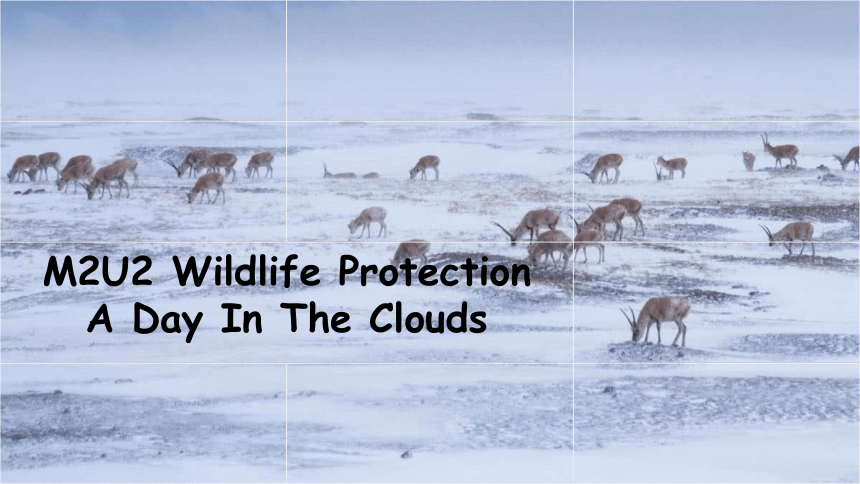 | |
| 格式 | pptx | ||
| 文件大小 | 28.6MB | ||
| 资源类型 | 教案 | ||
| 版本资源 | 人教版(2019) | ||
| 科目 | 英语 | ||
| 更新时间 | 2022-08-07 16:52:45 | ||
图片预览

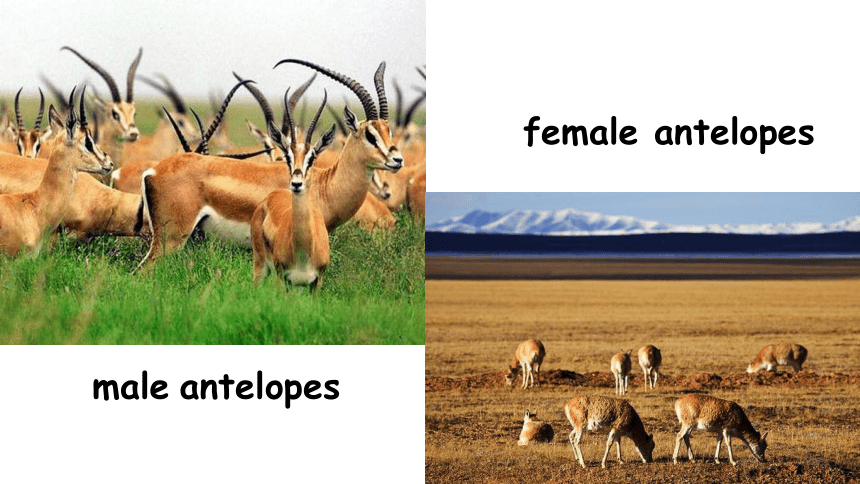

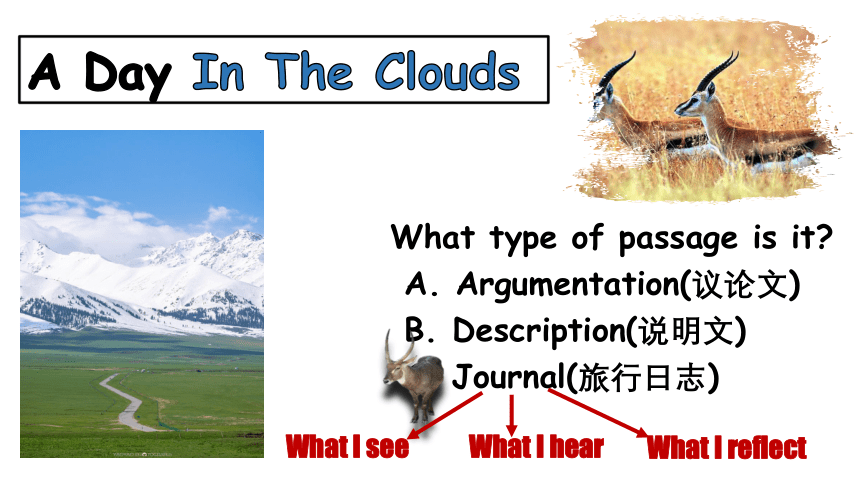
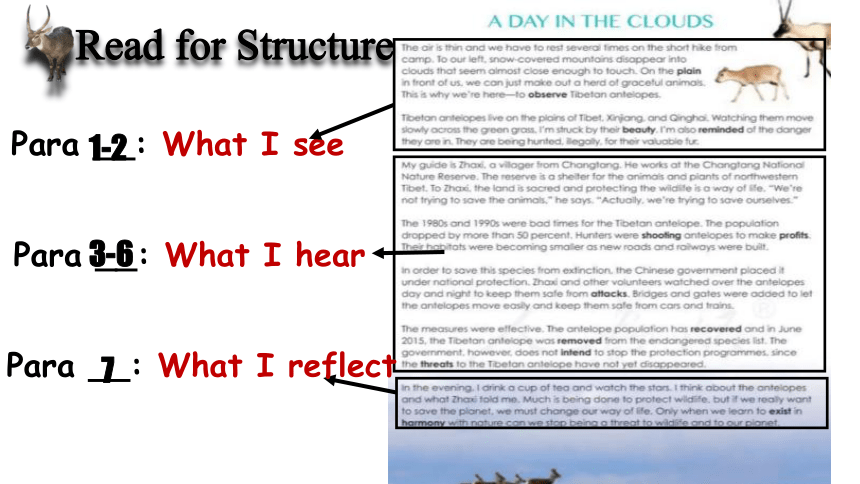
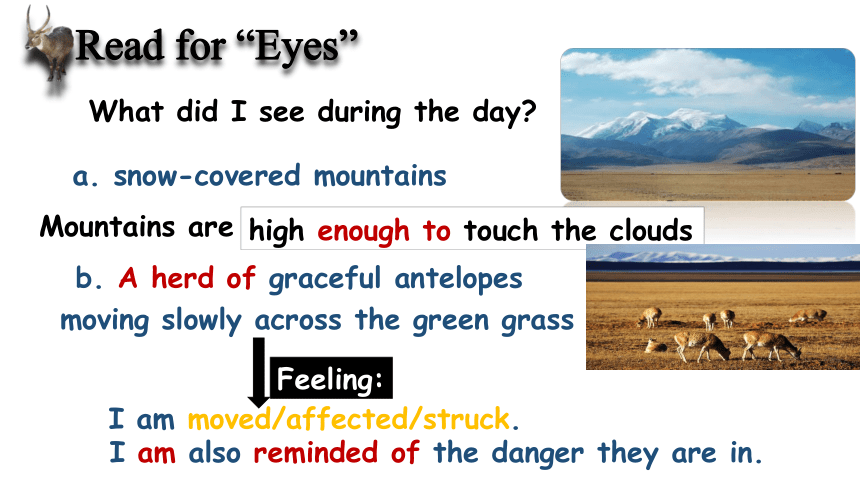
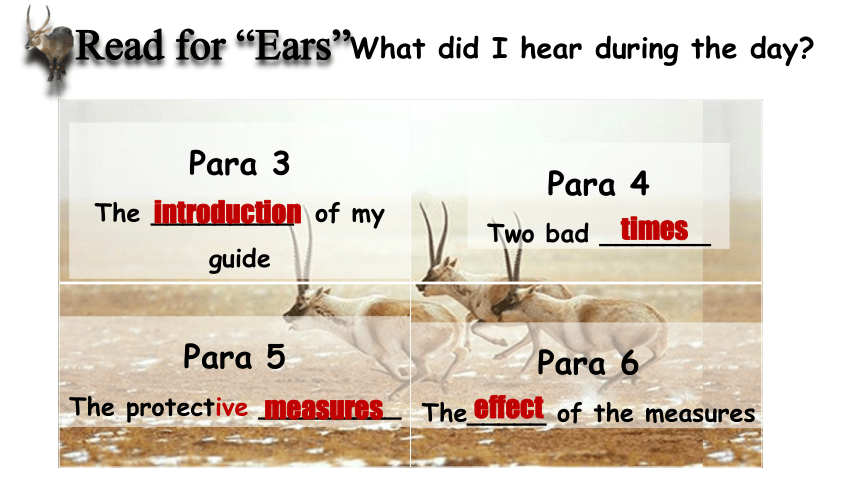
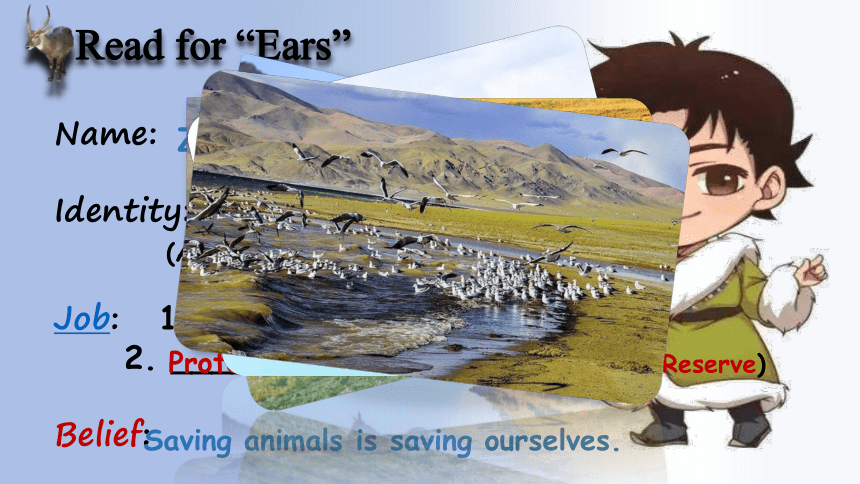

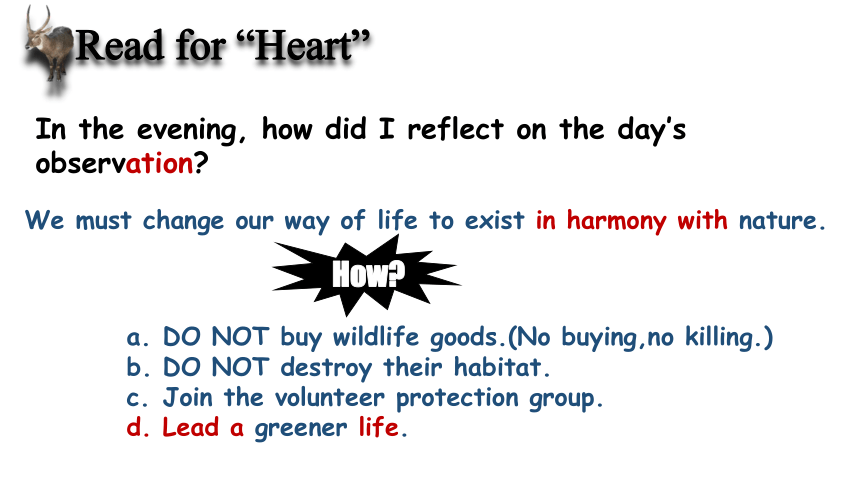
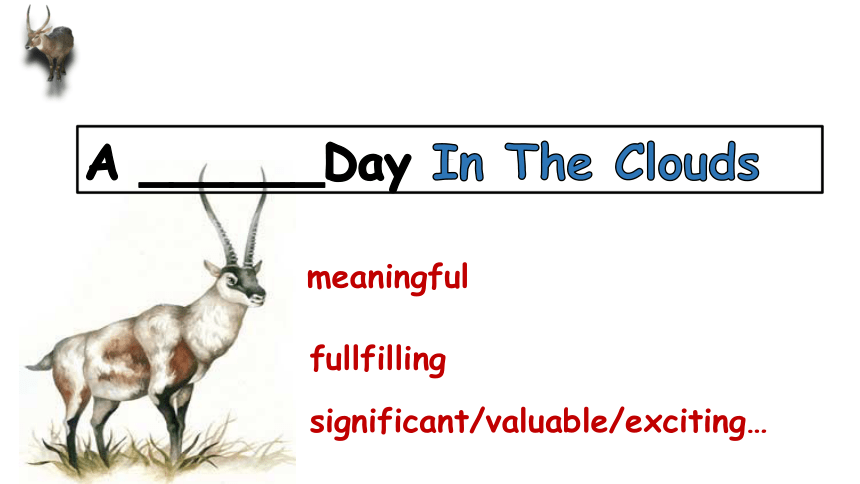
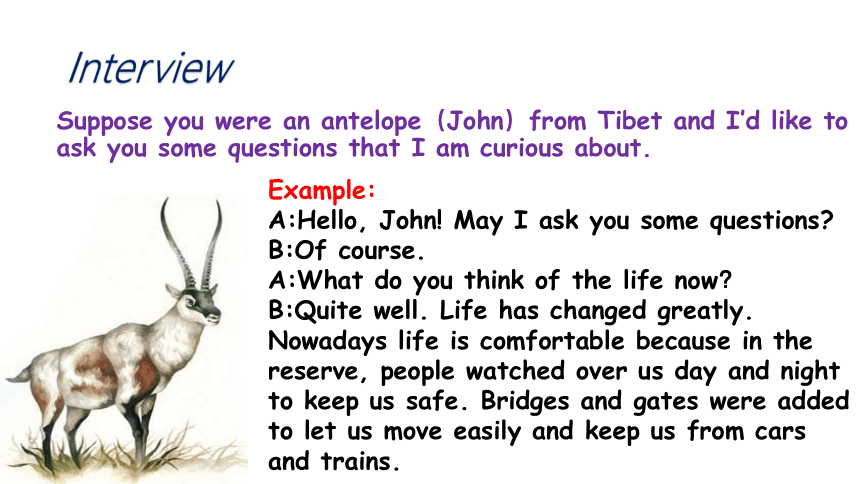
内容文字预览
(共34张PPT)
M2U2 Wildlife Protection A Day In The Clouds
male antelopes
female antelopes
A Day In The Clouds
What type of passage is it
A. Argumentation(议论文)
B. Description(说明文)
C. Journal(旅行日志)
What I see
What I hear
What I reflect
Read for Structure
Para __: What I see
Para __: What I hear
Para __: What I reflect
1-2
3-6
7
Read for “Eyes”
What did I see during the day
a. snow-covered mountains
Mountains are very high
high enough to touch the clouds
b. A herd of graceful antelopes
moving slowly across the green grass
I am moved/affected/struck.
I am also reminded of the danger they are in.
Feeling:
Read for “Ears”
Para 3
The _________ of my guide
Para 4
Two bad _______
Para 5
The protective _________
Para 6
The_____ of the measures
introduction
times
measures
effect
What did I hear during the day
Read for “Ears”
Name:
Identity: Tibetan
(A villager from Changtang)
Job: 1. Guide
2. ________
Belief:
Zhaxi
Saving animals is saving ourselves.
Protector (Changtang National Nature Reserve)
Read for “Ears”
200
47
60
300
50
100
150
200
250
1980
1996
2006
2021
Population
What did I hear during the day
(4-6)
drop
recover
a. Hunters were shooting…
b. Habitats were becoming smaller.
a. Government: national protection
b. People: watch over day and night
c. Bridges and gates were…
Result: It was removed from the endangered species list.
The government doesn’t intend to stop.
More can be done
(thousand)
Read for “Heart”
In the evening, how did I reflect on the day’s observation
We must change our way of life to exist in harmony with nature.
How
DO NOT buy wildlife goods.(No buying,no killing.)
DO NOT destroy their habitat.
Join the volunteer protection group.
Lead a greener life.
A ______Day In The Clouds
meaningful
significant/valuable/exciting…
fullfilling
Interview
Suppose you were an antelope(John)from Tibet and I’d like to ask you some questions that I am curious about.
Example:
A:Hello, John! May I ask you some questions
B:Of course.
A:What do you think of the life now?
B:Quite well. Life has changed greatly. Nowadays life is comfortable because in the reserve, people watched over us day and night to keep us safe. Bridges and gates were added to let us move easily and keep us from cars and trains.
.
Assignment
Suppose you were a Tibetan antelope. You were invited by WWF to give a speech on wildlife protection. Write at least 80 words. You may:
describe your past and present lives;
share what you want to say to humans;
tell other things you want to share.
Unit 2 A Day in the clouds (Book2)
reading and thinking
Main Contents
I. Analysis of teaching material
II. Teaching theories
III. Teaching methods and studying ways
IV. Teaching procedures
V. Blackboard design
VI. Teaching evaluation
Analysis of the teaching material
(教材分析)
language aims
thinking ability aims
3). Teaching key points 教学重点
4). Teaching difficult points 教学难点
1). Analysis of the teaching content 教材内容
5). The analysis of the students 学生分析
2). Teaching aims
教学目标
cultural awareness aims
1). Analysis of the teaching content
本单元主题是人与自然,围绕野生动物保护的主题展开。阅读文本 “A Day in the Clouds” 通过介绍藏羚羊过去和现在的生存环境,倡导每个人通过改变自身的生活方式来拯救野生动物、地球和人类。
本文是一篇日志体的文章,记录一天中所发生的事情。作者以第一人称的口吻讲述保护珍稀物种藏羚羊的故事。文章共有七个段落,结构完整,文字优美。第一段是引子,交代了作者当天的活动地点和活动目的。第二段在展现藏羚羊的优雅美丽的同时指出他们仍处在危险之中。第三段是扎西的野生物种保护理念和认识。第四段是介绍藏羚羊过去濒临灭绝的原因。第五段是政府和志愿者保护藏羚羊所采取的措施。第六段是保护措施所取得的成效。第七段是作者的感想,也是文章的立意所在--人类只有改变自己的生活方式,才能与自然和平相处。
语言能力目标
该文本行文逻辑清晰,教师可按照 “the present situation -- the past problems -- the measures -- the effect -- writer’s reflection”这条主线帮助学生厘清本文的框架。其中较典型的话题语言需要学生掌握:描述藏羚羊处于危险之中、濒临灭绝的话题语言和介绍保护藏羚羊的话题语言。这些话题语言的教学可以分部落实:在信息加工过程中,让学生初步感知文本中的话题语言;设计分类整理任务,巩固强化语言;创设应用语言语境,让学生充分应用所学语言。
2) Teaching aims
思维品质目标
根据标题和图片预测文章内容,培养学生运用已有知识构建文章基本内容的能力;通过概括主旨大意、梳理段落之间的逻辑关系,培养学生区分主要信息和次要信息的能力;通过辨别字面意义和隐含意义、猜测词义等活动使学生准确理解文本信息,提升学生的分析、推断、概括等思维品质。
2) Teaching aims
文化意识目标
该文本的主题语境是人与自然。通过文本学习,学生可以意识到人类为了自身利益而做出的一些非理性行为使得野生动物处于濒临灭绝的危险,人类只有改变对野生动物的态度和自身的生活方式,才能拯救野生动物,拯救地球。学生应在教师引导下学会如何在实践中真正有效地保护野生动物,提升保护野生动物的意识,并传播这些方法和理念,带动越来越多的人参与这项有意义的活动。
3) Teaching aims
3) Teaching key points
1.How to make students make clear the main content of the passage.
2.How to make students work out writer’s attitude to wildlife protection and express their own ideas bravely.
4) Teaching difficult points
1.How to guide students to understand the writer’s attitude to wildlife protection.
2.How to raise the students’awareness of protecting wildlife in daily life.
5). Analysis of the students
本课例授课对象为高一的学生,经过一个学期的语言能力、学习能力、思维品质和文化意识的培养,学生已基本具备用英语获取和处理信息、分析和解决问题的能力,对于阅读策略也有所了解,但是学生的阅读通常只限于对字面意义的理解而没有形成基于语篇学习主题的批判性思维、关键内容的开放性思维及主题要义的辩证性思维。
II. Teaching theories
新课标提出:英语课程的学习,既是学生通过英语学习和实践活动,逐步掌握英语知识和技能,提高语言实际运用能力的过程;又是他们陶冶情操、拓展视野、丰富社会经历、开发思维能力和提高人文素养的过程。本节课采用“基于批判性思维的阅读课”的教学模式。以任务为载体,以活动为主线,以学生为主体,把阅读的自主权还给学生,让学生自己研读、探究、体验,与文本对话。
III. Teaching methods and studying ways
Task-based teaching approach
Critical reading strategies
skimming Scanning
Pair work and individual work method
Teaching methods:
Studying methods:
Step 1 Lead-in
Two activities:
1.Free talk about antelopes
设计意图:通过图片呈现藏羚羊,引出主题。由学生自由表述来激活学生已有的背景知识。
核心素养提升点:语言能力:锻炼口头表达交流能力。
2.Watch a video to learn more about Tibet antelopes.
设计意图:视频补充,从而激发学生对接下来课堂内容的求知欲。
IV. Teaching procedures
1.What can you know according to the title and the picture (who, where, what)
One day, __________ went to_________to observe ___________.
2.What type of passage are we going to learn according to the the title, the picture and your prediction
A. Argumentation(议论文) B. Description(说明文) C. Journal(旅行日志)
3. What do people usually write in their journal
(what they see, what they hear, what they reflect)
4.Can you divide the passage into three parts
Step 2.prediction
设计意图:通过标题和图片的解读,让学生大致明白接下去要 学的内容。紧接着学生的预测让学生了解接下去要学的文本体裁是一篇旅游日志,再根据旅游日志的特点引导学生对文本进行分段处理。此步骤为之后的细读奠定基础。
核心素养提升点:学习能力:通过利用图片、题目文字等信息,学会预测文本的内容。
Step 3 Detail-reading
细节阅读
训练阅读
提高语言组织能力
Read the passage carefully and finish the following four reading tasks.
核心素养提升点:语言能力:感知话题语言,提升猜词能力和概括能力。
学习能力:学生能够辨析准确把握文本所传递的信息。
树立对野生动物进行保护并在日常生活中践行的意识。
1.For writer, the day is ___________.
2.Can you review the passage according to the tips
During the day, the author begins to know what antelopes went _______ in the past, such as being shot to ____ ______, and losing their_______. The author also learns about that the government and people have taken effective ________ to protect antelopes safe from ______. Luckily, the antelopes were removed _____ the list in 2015. But the government does not intend ______ the programmes, since the ______ have not disappeared. More can be done.
Step 4.Read for Summary
设计意图:引导学生对文本做个梳理。
核心素养提升点:引导学生使用关键词提炼主旨大意,锻炼学生的思维品质。
Step 5 Interview
Suppose you were an antelope John from Tibet and I’d like to ask you some questions that I am curious about.
设计意图:设置一个采访活动,让学生把课堂生成迁移运用,利用步骤三第二项任务自己提出的问题,模拟采访。
核心素养提升点:设置任务锻炼学生的语言能力,知识迁移能力。
Step 6. Homework
Suppose you were a Tibetan antelope. You were invited by WWF to give a speech on wildlife protection. Write at least 80 words. You may:
describe your past and present lives;
share what you want to say to humans;
tell other things you want to share.
设计意图:介绍藏羚羊的生活,巩固课堂上所学的词汇句型,发出保护野生动物的倡议,内化知识。
核心素养提升点:语言能力:运用所学内容和相关表达解决问题。
文化意识:呼吁倡导保护野生动物。
V. Blackboard design
A(n) day see snow-covered mountains
A herd of antelopes
hear Zhaxi’s belief
Two bad times
measures
effect
reflect what to do
A day in the clouds
VI. Teaching evaluation
1. Face all students, design different activities, try hard to arouse students’ interest.
2. Regard the students as the nucleus of teaching and respect the individual differences.
3. Attach as many opportunities as possible for the students to output after input.
M2U2 Wildlife Protection A Day In The Clouds
male antelopes
female antelopes
A Day In The Clouds
What type of passage is it
A. Argumentation(议论文)
B. Description(说明文)
C. Journal(旅行日志)
What I see
What I hear
What I reflect
Read for Structure
Para __: What I see
Para __: What I hear
Para __: What I reflect
1-2
3-6
7
Read for “Eyes”
What did I see during the day
a. snow-covered mountains
Mountains are very high
high enough to touch the clouds
b. A herd of graceful antelopes
moving slowly across the green grass
I am moved/affected/struck.
I am also reminded of the danger they are in.
Feeling:
Read for “Ears”
Para 3
The _________ of my guide
Para 4
Two bad _______
Para 5
The protective _________
Para 6
The_____ of the measures
introduction
times
measures
effect
What did I hear during the day
Read for “Ears”
Name:
Identity: Tibetan
(A villager from Changtang)
Job: 1. Guide
2. ________
Belief:
Zhaxi
Saving animals is saving ourselves.
Protector (Changtang National Nature Reserve)
Read for “Ears”
200
47
60
300
50
100
150
200
250
1980
1996
2006
2021
Population
What did I hear during the day
(4-6)
drop
recover
a. Hunters were shooting…
b. Habitats were becoming smaller.
a. Government: national protection
b. People: watch over day and night
c. Bridges and gates were…
Result: It was removed from the endangered species list.
The government doesn’t intend to stop.
More can be done
(thousand)
Read for “Heart”
In the evening, how did I reflect on the day’s observation
We must change our way of life to exist in harmony with nature.
How
DO NOT buy wildlife goods.(No buying,no killing.)
DO NOT destroy their habitat.
Join the volunteer protection group.
Lead a greener life.
A ______Day In The Clouds
meaningful
significant/valuable/exciting…
fullfilling
Interview
Suppose you were an antelope(John)from Tibet and I’d like to ask you some questions that I am curious about.
Example:
A:Hello, John! May I ask you some questions
B:Of course.
A:What do you think of the life now?
B:Quite well. Life has changed greatly. Nowadays life is comfortable because in the reserve, people watched over us day and night to keep us safe. Bridges and gates were added to let us move easily and keep us from cars and trains.
.
Assignment
Suppose you were a Tibetan antelope. You were invited by WWF to give a speech on wildlife protection. Write at least 80 words. You may:
describe your past and present lives;
share what you want to say to humans;
tell other things you want to share.
Unit 2 A Day in the clouds (Book2)
reading and thinking
Main Contents
I. Analysis of teaching material
II. Teaching theories
III. Teaching methods and studying ways
IV. Teaching procedures
V. Blackboard design
VI. Teaching evaluation
Analysis of the teaching material
(教材分析)
language aims
thinking ability aims
3). Teaching key points 教学重点
4). Teaching difficult points 教学难点
1). Analysis of the teaching content 教材内容
5). The analysis of the students 学生分析
2). Teaching aims
教学目标
cultural awareness aims
1). Analysis of the teaching content
本单元主题是人与自然,围绕野生动物保护的主题展开。阅读文本 “A Day in the Clouds” 通过介绍藏羚羊过去和现在的生存环境,倡导每个人通过改变自身的生活方式来拯救野生动物、地球和人类。
本文是一篇日志体的文章,记录一天中所发生的事情。作者以第一人称的口吻讲述保护珍稀物种藏羚羊的故事。文章共有七个段落,结构完整,文字优美。第一段是引子,交代了作者当天的活动地点和活动目的。第二段在展现藏羚羊的优雅美丽的同时指出他们仍处在危险之中。第三段是扎西的野生物种保护理念和认识。第四段是介绍藏羚羊过去濒临灭绝的原因。第五段是政府和志愿者保护藏羚羊所采取的措施。第六段是保护措施所取得的成效。第七段是作者的感想,也是文章的立意所在--人类只有改变自己的生活方式,才能与自然和平相处。
语言能力目标
该文本行文逻辑清晰,教师可按照 “the present situation -- the past problems -- the measures -- the effect -- writer’s reflection”这条主线帮助学生厘清本文的框架。其中较典型的话题语言需要学生掌握:描述藏羚羊处于危险之中、濒临灭绝的话题语言和介绍保护藏羚羊的话题语言。这些话题语言的教学可以分部落实:在信息加工过程中,让学生初步感知文本中的话题语言;设计分类整理任务,巩固强化语言;创设应用语言语境,让学生充分应用所学语言。
2) Teaching aims
思维品质目标
根据标题和图片预测文章内容,培养学生运用已有知识构建文章基本内容的能力;通过概括主旨大意、梳理段落之间的逻辑关系,培养学生区分主要信息和次要信息的能力;通过辨别字面意义和隐含意义、猜测词义等活动使学生准确理解文本信息,提升学生的分析、推断、概括等思维品质。
2) Teaching aims
文化意识目标
该文本的主题语境是人与自然。通过文本学习,学生可以意识到人类为了自身利益而做出的一些非理性行为使得野生动物处于濒临灭绝的危险,人类只有改变对野生动物的态度和自身的生活方式,才能拯救野生动物,拯救地球。学生应在教师引导下学会如何在实践中真正有效地保护野生动物,提升保护野生动物的意识,并传播这些方法和理念,带动越来越多的人参与这项有意义的活动。
3) Teaching aims
3) Teaching key points
1.How to make students make clear the main content of the passage.
2.How to make students work out writer’s attitude to wildlife protection and express their own ideas bravely.
4) Teaching difficult points
1.How to guide students to understand the writer’s attitude to wildlife protection.
2.How to raise the students’awareness of protecting wildlife in daily life.
5). Analysis of the students
本课例授课对象为高一的学生,经过一个学期的语言能力、学习能力、思维品质和文化意识的培养,学生已基本具备用英语获取和处理信息、分析和解决问题的能力,对于阅读策略也有所了解,但是学生的阅读通常只限于对字面意义的理解而没有形成基于语篇学习主题的批判性思维、关键内容的开放性思维及主题要义的辩证性思维。
II. Teaching theories
新课标提出:英语课程的学习,既是学生通过英语学习和实践活动,逐步掌握英语知识和技能,提高语言实际运用能力的过程;又是他们陶冶情操、拓展视野、丰富社会经历、开发思维能力和提高人文素养的过程。本节课采用“基于批判性思维的阅读课”的教学模式。以任务为载体,以活动为主线,以学生为主体,把阅读的自主权还给学生,让学生自己研读、探究、体验,与文本对话。
III. Teaching methods and studying ways
Task-based teaching approach
Critical reading strategies
skimming Scanning
Pair work and individual work method
Teaching methods:
Studying methods:
Step 1 Lead-in
Two activities:
1.Free talk about antelopes
设计意图:通过图片呈现藏羚羊,引出主题。由学生自由表述来激活学生已有的背景知识。
核心素养提升点:语言能力:锻炼口头表达交流能力。
2.Watch a video to learn more about Tibet antelopes.
设计意图:视频补充,从而激发学生对接下来课堂内容的求知欲。
IV. Teaching procedures
1.What can you know according to the title and the picture (who, where, what)
One day, __________ went to_________to observe ___________.
2.What type of passage are we going to learn according to the the title, the picture and your prediction
A. Argumentation(议论文) B. Description(说明文) C. Journal(旅行日志)
3. What do people usually write in their journal
(what they see, what they hear, what they reflect)
4.Can you divide the passage into three parts
Step 2.prediction
设计意图:通过标题和图片的解读,让学生大致明白接下去要 学的内容。紧接着学生的预测让学生了解接下去要学的文本体裁是一篇旅游日志,再根据旅游日志的特点引导学生对文本进行分段处理。此步骤为之后的细读奠定基础。
核心素养提升点:学习能力:通过利用图片、题目文字等信息,学会预测文本的内容。
Step 3 Detail-reading
细节阅读
训练阅读
提高语言组织能力
Read the passage carefully and finish the following four reading tasks.
核心素养提升点:语言能力:感知话题语言,提升猜词能力和概括能力。
学习能力:学生能够辨析准确把握文本所传递的信息。
树立对野生动物进行保护并在日常生活中践行的意识。
1.For writer, the day is ___________.
2.Can you review the passage according to the tips
During the day, the author begins to know what antelopes went _______ in the past, such as being shot to ____ ______, and losing their_______. The author also learns about that the government and people have taken effective ________ to protect antelopes safe from ______. Luckily, the antelopes were removed _____ the list in 2015. But the government does not intend ______ the programmes, since the ______ have not disappeared. More can be done.
Step 4.Read for Summary
设计意图:引导学生对文本做个梳理。
核心素养提升点:引导学生使用关键词提炼主旨大意,锻炼学生的思维品质。
Step 5 Interview
Suppose you were an antelope John from Tibet and I’d like to ask you some questions that I am curious about.
设计意图:设置一个采访活动,让学生把课堂生成迁移运用,利用步骤三第二项任务自己提出的问题,模拟采访。
核心素养提升点:设置任务锻炼学生的语言能力,知识迁移能力。
Step 6. Homework
Suppose you were a Tibetan antelope. You were invited by WWF to give a speech on wildlife protection. Write at least 80 words. You may:
describe your past and present lives;
share what you want to say to humans;
tell other things you want to share.
设计意图:介绍藏羚羊的生活,巩固课堂上所学的词汇句型,发出保护野生动物的倡议,内化知识。
核心素养提升点:语言能力:运用所学内容和相关表达解决问题。
文化意识:呼吁倡导保护野生动物。
V. Blackboard design
A(n) day see snow-covered mountains
A herd of antelopes
hear Zhaxi’s belief
Two bad times
measures
effect
reflect what to do
A day in the clouds
VI. Teaching evaluation
1. Face all students, design different activities, try hard to arouse students’ interest.
2. Regard the students as the nucleus of teaching and respect the individual differences.
3. Attach as many opportunities as possible for the students to output after input.
